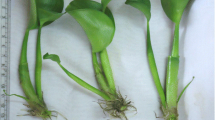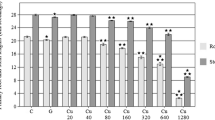Abstract
Mercury (Hg) is one of the major toxic heavy metals because it bioaccumulates and biomagnifies in animal and human bodies via the food chain. To eliminate heavy metal contamination, plants are being used as removal agents of pollutants/toxic chemicals from the environment. The present study was mainly focused on elucidating the potential phytotoxic effects of Hg heavy metal ion exposure on Sesbania grandiflora seedlings. Growth of seedlings was significantly affected (56 %) at 60 mg L−1 Hg concentration. The level of chlorophyll pigment contents was increased in Hg-treated plants compared to the control. Malondialdehyde content and antioxidative enzyme activities were found to be significantly increased by increasing the concentration of Hg exposure up to 40 mg L−1 while slightly decreased at higher doses. The DNA alterations appearing in the random amplified polymorphic DNA (RAPD) profiles of leaf and root tissues following Hg heavy metal exposure included the disappearance of normal DNA bands and the appearance of new bands compared to the untreated controls. This result strongly indicated that genomic template stability was significantly affected by Hg-induced stress in S. grandiflora seedlings. It is concluded that DNA polymorphisms detected by RAPD fingerprinting analysis could be used as potential molecular markers for the evaluation of Hg heavy metal ion-induced genotoxic effects in other plant species.




Similar content being viewed by others
References
Ahmad MA, Guar R, Gupta M (2012) Comparative biochemical and RAPD analysis in two varieties of rice (Oryza sativa) under arsenic stress by using various biomarkers. J Hazard Mater 217–218:141–148
Aksakal O, Erturk FA, Sunar S, Bozari S, Agar G (2013) Assessment of genotoxic effects of 2,4-dichlorophenoxyacetic acid on maize by using RAPD analysis. Ind Crops Prod 42:552–557
Alscher RG, Erturk NL (2002) Role of superoxide dismutases (SODs) in controlling oxidative stress in plants. Environ Exp Bot 53:1331–1341
Atienzar FA, Jha AN (2004) The random amplified polymorphic DNA (RAPD) assay to determine DNA alterations, repair and transgenerational effects in B(a)P exposed Daphnia magna. Mutat Res 552:125–140
Beauchamp C, Fridovich I (1971) Superoxide dismutase: improved assays and an assay applicable to acrylamide gels. Anal Biochem 44:276–287
Beer JRF, Sizer IW (1952) A spectrophotometric method for measuring the breakdown of hydrogen peroxide by catalase. J Biol Chem 195:133–140
Bradford MM (1976) A rapid and sensitive method for the quantification of microgram quantities of protein utilizing the principle of protein binding. Anal Biochem 72:248–254
Cenkci S, Yildiz M, Cigerci IH, Konuk M, Bozdag A (2009) Toxic chemicals-induced genotoxicity detected by random amplified polymorphic DNA (RAPD) in bean (Phaseolus vulgaris L.) seedlings. Chemosphere 76:900–906
Cenkci S, Cigerci IH, Yildiz M, Ozay C, Bozdag A (2010) Lead contamination reduces chlorophyll and genomic template stability in Brassica napa L. Environ Exp Bot 67:467–473
Chen J, Shiyab S, Han FX, Monts DL, Waggoner AW, Su ZY (2009) Bioaccumulation and physiological effects of mercury in Pteris vittata and Nephrolepis exaltata. Ecotoxicology 18:110–121
Conceição FT, Navarro GRB, Silva AM (2013) Anthropogenic influences on Cd, Cr, Cu, Ni, Pb and Zn concentrations in soils and sediments in a watershed with sugar cane crops at São Paulo State, Brazil. Int J Environ Res 7(3):551–560
Davenport SB, Gallego SM, Benavides MP, Tomarow ML (2003) Behaviour of antioxidant defense system in the adaptive response to salt stress in Helianthus annus L. J Plant Growth Regul 40:81–88
Doyle JJ, Doyle JL (1990) Isolation of plant DNA from fresh tissue. Focus 12:13–15
Feng-tao LI, Jian-min QI, Gao-yang Z, Li-hui L, Ping-ping F, Fen TA, Jian-tang XU (2013) Effect of cadmium stress on the growth, antioxidative enzymes and lipid peroxidation in two kenaf (Hibiscus cannabinus L.) plant seedlings. J Int Agri 12:610–620
Gallego S, Benavides M, Tomarow A (2002) Involvement of an antioxidant defense system in the adaptive response to heavy metal ions in Helianthus annus L. cells. Plant Growth Regul 36:267–273
Gao S, Yang C, Tang L, Zhu J, Xu Y, Wang S, Chen F (2010) Growth and antioxidant responses in Jatropha curcas seedling exposed to mercury toxicity. J Hazard Mater 182:591–597
Hagger JA, Atienzar FA, Jha AN (2006) Genotoxic, cytotoxic, developmental and survival effects of tritiated water in the early life stages of the marine mollusc, Mytilus edulis. Aquatic Toxicol 74:205–217
Hoagland R, Arnon DI (1950) The water-culture method of growing plants without soil. Calif Agric Exp Station Circ 347:1–32
Hou W, Chen X, Song G, Wang Q, Chang CC (2007) Effects of copper and cadmium on heavy metal polluted water body restoration by duckweed (Lemna minor). Plant Physiol Biochem 45:62–69
Hu R, Sunc K, Suc X, Pana Y, Zhang Y (2012) Physiological responses and tolerance mechanisms to Pb in two xerophils: Salsola passerina Bunge and Chenopodium album L. J Hazard Mater 205–206:131–138
Israr M, Sahi SV (2006) Antioxidative responses to mercury in the cell cultures of Sesbania drummondii. Plant Physiol Biochem 44:590–595
Korpe DA, Aras S (2011) Evaluation of copper-induced stress on eggplant (Solanum melongena L.) seedlings at the molecular and population levels by use of various biomarkers. Mutat Res 719:29–34
Li B, Shi JB, Wang X, Meng M, Huang L, Qi XL, He B, Ye ZH (2013) Variations and constancy of mercury and methylmercury accumulation in rice grown at contaminated paddy field sites in three Provinces of China. Environ Pollut 181:91–97
Lichtenthaler HK (1987) Chlorophylls and carotenoids: pigments of photosynthetic biomembranes. Methods Enzymol 148:350–382
Liu W, Yang YS, Li PJ, Zhou QX, Xie LJ, Han YP (2009) Risk assessment of cadmium-contaminated soil on plant DNA damage using RAPD and physiological indices. J Hazard Mater 161:878–883
Lomonte C, Sgherri C, Baker JM, Kolev SD, Navari-Izzo F (2010) Antioxidative responses of Atriplex codonocarpa to mercury. Environ Exp Bot 69:9–16
Malecka A, Piochalak A, Tomaszewska B (2009) Reactive oxygen species production and antioxidative defense system in pea root tissues treated with lead ions: the whole roots level. Acta Physiol Plant 31:1053–1063
Manikandan R, Venkatachalam P (2011) Risk assessment of mercury ion heavy metal exposure on physiological and biochemical changes and DNA damage using RAPD analysis in Mentha arvensis seedlings. Plant Cell Biotech Mol Biol 12:41–50
Marchiol L, Assolari S, Sacro P, Zerbia A (2004) Phytoremediation of heavy metals by Canola (Brassica napus) and radish (Raplanus sativus) grown on multi contaminated soil. Environ Pollut 132:21–27
Meng B, Feng X, Qiu G, Cai Y, Wang D (2010) Distribution patterns of inorganic mercury and methylmercury in tissues of rice (Oryza sativa L.) plants and possible bioaccumulation pathways. J Agric Food Chem 58:4951–4958
Mishra S, Srivastava S, Tripathi RD, Govindarajan R, Kuriakose SV, Prasad MNV (2006) Phytochelation synthesis and responses of antioxidants during cadmium stress in Bacopa monnieri L. Plant Physiol Biochem 44:25–37
Moaref S, Sekhavatjou MS, Hosseini Alhashemi A (2014) Determination of trace elements concentration in wet and dry atmospheric deposition and surface soil in the largest industrial city, Southwest of Iran. Int J Environ Res 8(2):335–346
Nakano Y, Asada K (1987) Purification of ascorbate peroxidase in spinach chloroplasts: its inactivation in ascorbate depleted medium and reactivation by monodehydroascorbate radical. Plant Cell Physiol 28:131–140
Noctor G, Foyer CH (1998) Ascorbate and glutathione: keeping active oxygen under control. Plant Physiol Plant Mol Biol 49:249–279
Parlak KC, Yilmaz DD (2013) Ecophysiological tolerance of Lemna gibba L. exposed to cadmium. Ecotoxicol Environ Saf 91:79–85
Pilon-Smits E, Pilon M (2000) Breeding mercury-breathing plants for environmental cleanup. Trends Plant Sci 5:235–236
Quintela-Sabaris C, Kidd PS, Fraga MI (2005) Identification of metalliferous ecotypes of Cistus ladanifer L. using RAPD markers. Z Naturforsch 60:229–235
Radotic K, Ducic T, Mutavdzic D (2000) Changes in peroxidase activity and isoenzymes in spruce needles after exposure to different concentrations of cadmium. Environ Exp Bot 44:105–113
Sinha S, Saxena R (2006) Effect of iron on lipid peroxidation, and enzymatic and non-enzymatic antioxidants and bacoside-A content in medicinal plant Bacopa monnieri L. Chemosphere 62:1340–1350
Sinha S, Saxena R, Singh S (2005) Chromium induced lipid peroxidation in the plants of Pistia stratiotes L.: role of antioxidants and antioxidant enzymes. Chemosphere 58:595–604
Suszcynsky EM, Shan JR (1995) Phytotoxicity and accumulation of mercury in tobacco subjected to different exposure routes. Environ Toxicol Chem 14:61–67
Taghinia Hejabi A, Basavarajappa HT, Qaid Saeed AM (2010) Heavy metal pollution in Kabini river sediments. Int J Environ Res 4(4):629–636
Venkatachalam P, Srivastava AK, Raghothama KG, Sahi SV (2009) Genes induced in response to mercury-ion-exposure in heavy metal hyperaccumulator Sesbania drummondii. Environ Sci Technol 43:843–850
Wang M, Zhou Q (2005) Single and joint toxicity of chlorimuron-ethyl, cadmium and copper acting on wheat Triticum aestivum. Ecotoxicol Environ Saf 60:169–175
Willekens H, Chamnongpol S, Davey M, Schraudner M, Langebartels C, Van Montagu M, Inzé D, Van Camp W (1997) Catalase is a sink for H2O2 and is indispensable for stress defense in C3 plants. Eur Mol Biol Org 16:4806–4816
Williams J, Kubelik AR, Livak KJ (1990) DNA polymorphisms amplified by arbitrary primers are useful as genetic markers. Nucleic Acid Res 18:6531–6535
Zavoda J, Cutright T, Szpak J, Fallon E (2001) Uptake, selectivity, and inhibition of hydroponic treatment of contaminants. J Environ Eng 127:502–508
Zhang J, Cui S, Kirkham MB (1995) Protoplasmic factors, antioxidant responses and chilling resistance in maize. Plant Physiol Biochem 33:567–575
Zhang FQ, Wang YS, Lou ZP, Dong JD (2007) Effect of heavy metal stress on antioxidative enzymes and lipid peroxidation in leaves and roots of two mangrove plant seedlings (Kandelia candel and Bruguiera gymnorrhiza). Chemosphere 67:44–50
Zhou ZS, Huang SQ, Guo K, Mehta SK, Zhang PC, Yang ZM (2007) Metabolic adaptation to mercury-induced oxidative stress in roots of Medicago sativa L. J Inorg Biochem 101:1–9
Acknowledgments
Authors gratefully acknowledge Mr. R. Manikandan, Department of Biotechnology, Periyar University, for his kind help rendered during statistical analysis.
Author information
Authors and Affiliations
Corresponding author
Rights and permissions
About this article
Cite this article
Malar, S., Sahi, S.V., Favas, P.J.C. et al. Assessment of mercury heavy metal toxicity-induced physiochemical and molecular changes in Sesbania grandiflora L.. Int. J. Environ. Sci. Technol. 12, 3273–3282 (2015). https://doi.org/10.1007/s13762-014-0699-4
Received:
Revised:
Accepted:
Published:
Issue Date:
DOI: https://doi.org/10.1007/s13762-014-0699-4




